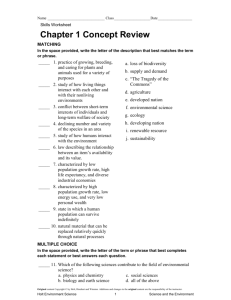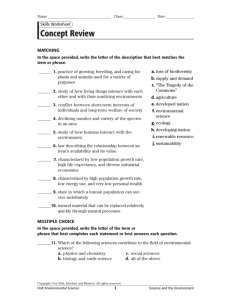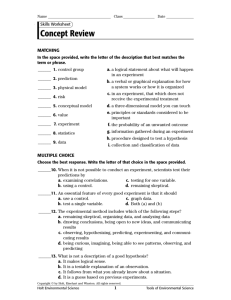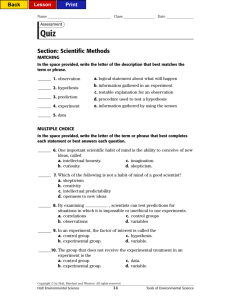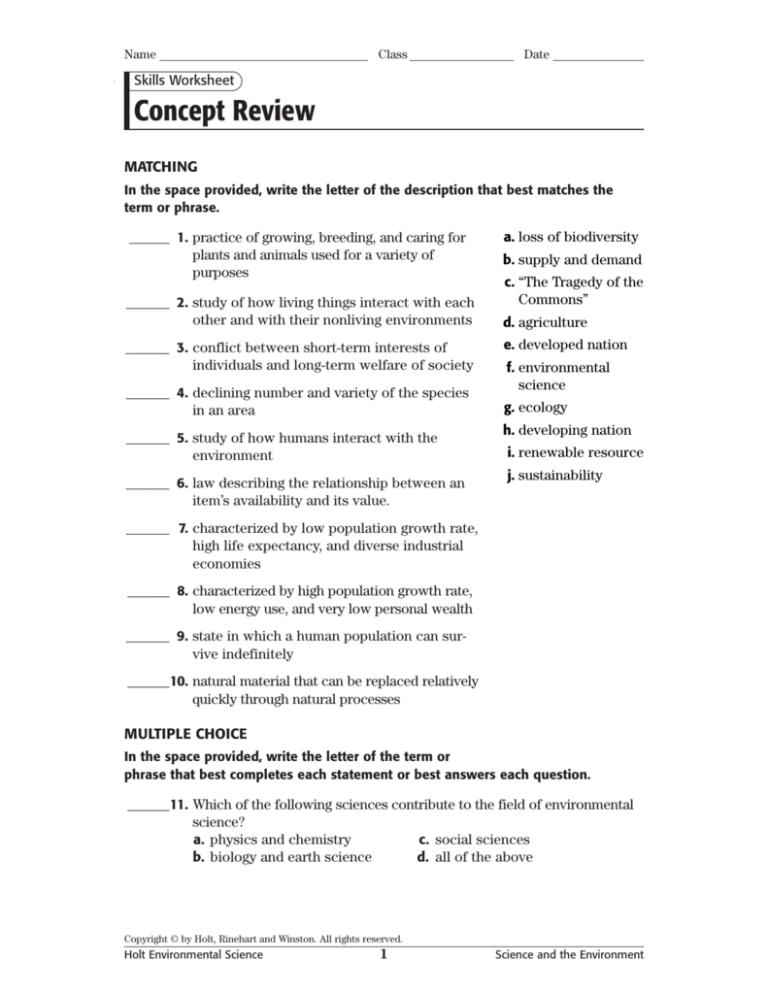
Name
Class
Date
Skills Worksheet
Concept Review
MATCHING
In the space provided, write the letter of the description that best matches the
term or phrase.
______ 1. practice of growing, breeding, and caring for
plants and animals used for a variety of
purposes
______ 2. study of how living things interact with each
other and with their nonliving environments
______ 3. conflict between short-term interests of
individuals and long-term welfare of society
______ 4. declining number and variety of the species
in an area
______ 5. study of how humans interact with the
environment
______ 6. law describing the relationship between an
item’s availability and its value.
a. loss of biodiversity
b. supply and demand
c. “The Tragedy of the
Commons”
d. agriculture
e. developed nation
f. environmental
science
g. ecology
h. developing nation
i. renewable resource
j. sustainability
______ 7. characterized by low population growth rate,
high life expectancy, and diverse industrial
economies
______ 8. characterized by high population growth rate,
low energy use, and very low personal wealth
______ 9. state in which a human population can survive indefinitely
______10. natural material that can be replaced relatively
quickly through natural processes
MULTIPLE CHOICE
In the space provided, write the letter of the term or
phrase that best completes each statement or best answers each question.
______11. Which of the following sciences contribute to the field of environmental
science?
a. physics and chemistry
c. social sciences
b. biology and earth science
d. all of the above
Copyright © by Holt, Rinehart and Winston. All rights reserved.
Holt Environmental Science
1
Science and the Environment
Name
Class
Date
Concept Review continued
______12. All of the following make up the three major categories of environmental
problems except
a. loss of biodiversity.
c. resource depletion.
b. overpopulation.
d. pollution.
, human
______13. During the period of human history known as the
populations grew rapidly because of advances in farming methods.
a. Industrial Revolution
c. “Tragedy of the Commons”
b. agricultural revolution
d. hunter-gatherer period
______14. Which major changes in human society and the environment occurred
during the Industrial Revolution?
a. People lived in small tribes; many mammals went extinct.
b. Domesticated plants were altered; forest was replaced with farmland.
c. Fossil fuel consumption, technological efficiency, and environmental
pollution increased.
d. Common grazing areas were replaced with closed fields.
______15. What did hunter-gatherers do to alter the environment?
a. introduce plants to new
c. burn prairie to maintain
regions
grassland
b. overhunt large mammals d. all of the above
______16. Developed nations make up about
population and consume about
a. 20, 75
c. 75, 20
b. 50, 75
d. 75, 50
percent of the world’s
percent of its resources.
______ 17. Hardin’s “Tragedy of the Commons” essay addressed the conflicts
associated with which environmental challenge?
a. preventing pollution
c. curbing overpopulation
b. preserving biodiversity
d. protecting shared resources
______18. The ecological footprint for a person in a particular country takes into
account what requirements of supporting that individual?
a. land used for crops
c. forest area that absorbs pollution
b. land taken up by housing d. all of the above
______19. Attempts to create a sustainable society strive to achieve what?
a. greater resource consumption c. negative population growth
b. stable resource consumption d. restrictions on technology
______20. A cost-benefit analysis balances the cost of an action against
a. those who benefit from the action.
b. those who perform the analysis.
c. what consumers and taxpayers are willing to pay.
d. the benefits one expects to receive.
Copyright © by Holt, Rinehart and Winston. All rights reserved.
Holt Environmental Science
2
Science and the Environment
Name
Class
Date
Skills Worksheet
Critical Thinking
ANALOGIES
Mark the letter of the pair of terms that best completes the analogy shown.
An analogy is a relationship between two pairs of words or phrases written as
a : b :: c : d. The symbol : is read “is to,” and the symbol :: is read “as.”
______ 1. Industrial Revolution :
Agricultural Revolution ::
a. animal muscle : fossil
fuels
b. hunters : gatherers
c. agricultural revolution :
hunter-gatherers
d. hunter-gatherers :
population growth
______ 5. ecological footprint : land ::
a. developed nation :
consumption
b. developing nation :
consumption
c. grazing : forest products
d. land : ocean
______ 2. pollution : health effects ::
a. industrial : revolution
b. cyanide : smog
c. extinction : biodiversity
d. automobiles : exhaust
______ 6. supply : demand ::
a. overpopulation :
resources
b. renewable : nonrenewable
c. computer production :
sales of computers
d. population : consumption
______ 3. environmental science :
biology ::
a. botany : zoology
b. biology : zoology
c. zoology : geology
d. social sciences :
chemistry
______ 7. commons : overgrazing ::
a. Earth : resources
b. short-term interests :
long-term interests
c. individual lands :
sustainability
d. individuals : society
______ 4. renewable resource :
nonrenewable resource ::
a. iron : water
b. trees : sunlight
c. water : trees
d. trees : oil
______ 8. biodegradable :
nonbiodegradable ::
a. pollutant : toxin
b. plastic : newspaper
c. cotton : polyester
d. mercury : lead
Copyright © by Holt, Rinehart and Winston. All rights reserved.
Holt Environmental Science
3
Science and the Environment
Name
Class
Date
Critical Thinking continued
INTERPRETING OBSERVATIONS
Read the following scenario, and answer the questions that follow.
Four students are given the assignment of classifying countries as developing
or developed. Each student gathers the following information for one nation:
per-person annual income, population growth rate, and tons of carbon dioxide
produced by fossil fuels. The students compile their results in bar graphs.
2
33,000
32,000
31,000
Population Growth Rate
Per Year (%)
Per-Person Annual Income ($)
35,000
34,000
1.5
30,000
5,000
4,000
3,000
2,000
1,000
0
1
0.5
A
B
C
Countries
D
0
A
B
C
Countries
D
Carbon Dioxide Released Annually
Per Person (tons)
Figure 1
20
15
10
5
0
A
B
C
D
Countries
9. Which country or countries would you classify as developing? Describe your
reasoning.
10. Which country or countries are likely to have the highest rates of energy
consumption? Explain your answer.
11. Which country is most likely the United States? How can you tell?
Copyright © by Holt, Rinehart and Winston. All rights reserved.
Holt Environmental Science
4
Science and the Environment
Name
Class
Date
Critical Thinking continued
AGREE OR DISAGREE
Agree or disagree with the following statements, and support your answers.
12. Because large-scale species extinctions have occurred throughout Earth’s
history, we should not be concerned by the world’s current high extinction rate.
13. Growing populations do not create social or environmental problems in areas
where food resources are not limited.
14. Most people from developing countries have values and priorities very
different from those of most people from developed countries.
Copyright © by Holt, Rinehart and Winston. All rights reserved.
Holt Environmental Science
5
Science and the Environment
Name
Class
Date
Critical Thinking continued
REFINING CONCEPTS
The statements below challenge you to refine your understanding of concepts
covered in the chapter. Think carefully, and answer the questions that follow.
15. The “ecological footprint” of a citizen of a developed nation is about four
times larger than that of a citizen of a developing nation. Why do you think
this is the case?
16. If you could travel in time to a period before the Industrial Revolution, what
actions would you initiate to minimize current environmental problems?
17. Solutions to complex environmental problems can be very costly. Communities
or other affected groups might perform a cost-benefit analysis to determine
whether the benefits of the desired solutions outweigh the financial cost. How
might the results of a cost-benefit analysis be interpreted differently by a local
citizen, a company CEO, and a city manager who monitors city funds while
overseeing major improvement projects?
Copyright © by Holt, Rinehart and Winston. All rights reserved.
Holt Environmental Science
6
Science and the Environment
Name
Class
Date
Critical Thinking continued
18. If Earth is considered a “closed system,” how does that shape the outcome
of environmental problems? How does this relate to local or regional environmental problems?
19. Identify a controversial environmental issue in your community that fits into
one of the following three major categories: resource depletion, pollution, or
loss of biodiversity. Discuss how the issue is being addressed, and whether or
not the conflicts associated with “The Tragedy of the Commons” are affecting
solutions to the problems.
Copyright © by Holt, Rinehart and Winston. All rights reserved.
Holt Environmental Science
7
Science and the Environment

